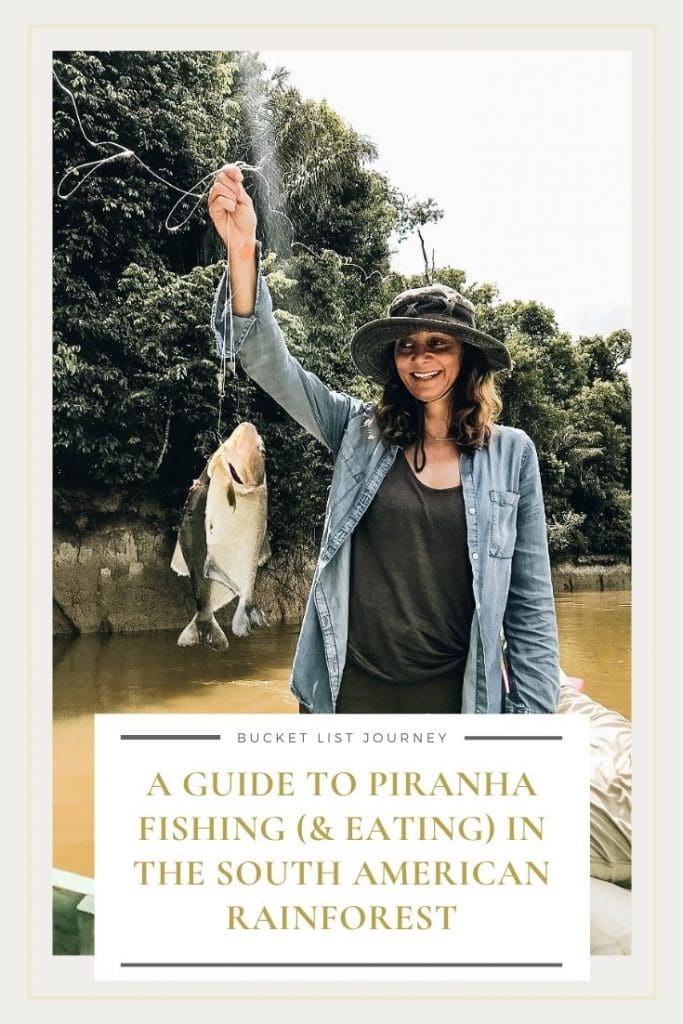When you hear the word piranha, what comes to mind? For me it’s a little fish with ginormous teeth that can eat a person alive (at least according to the horror movie of the same name). But there’s so much more to this ancient, and somewhat misunderstood, fish. For instance, not only are they a popular sight to see while traversing around Amazon, but piranha fishing is a well-liked activity to do as well (along with a trip to Kaieteur Falls, it was one of my favorite things to do in Guyana!).
Not to mention, piranhas are actually also a dish you can eat! In this guide you’ll learn more about what piranhas actually are, as well as how to fish and eat them. Will piranha fishing become yet another thing on your ever growing bucket list?

A Guide to Piranha Fishing (& Eating) in the South American Rainforest
Piranha Facts and Description
What are Piranha?
The roots of piranha go all the way back to 25 million years ago, with the modern piranha, the one we know today, has been around for nearly 2 million years.
Though compared to Guyana’s popular Arapaima fish they are relatively small in size, ranging on average from 5-14 inches, their reputation as a predator makes them one of the most feared fishes in the world. The coloring of a piranha also depends on their species, with most of them having a silvery or golden body, and many also have red and other bright coloring in their belly, fin, and head area.
Piranhas (also known as piranas) are freshwater fish infamous for their very sharp triangle-shaped teeth and strong jaws that produce a forceful bite (have you ever seen the scary movie of the same name?). They have the ability to replace these teeth as it’s also relatively common for the fish to lose some of their teeth during their life.
Where Can you Find Piranha?
Piranhas can be found in multiple places in South America. Tropical rivers and streams are liked by piranhas, and your best bet to find one is in murky or muddy waters. Location-wise, they can be found as north as Venezuela and as south as Argentina. Especially the Amazon rainforest expanding into several countries besides Brazil, as well as the Iwokrama Forest in Guyana. Actually about 90% of the rivers and lakes in Guyana have piranha!
What do Piranhas Eat?
Most often piranhas eat bugs, crustaceans, insects, scraps, and plant materials, as well as fish. Additionally, some piranhas live solely on a vegetarian diet. Lastly, where competition for food is high with inadequate food resources available, piranhas are known to resort to cannibalism and bite into a fellow piranha.
How Dangerous are They?
Contrary to popular belief, in large part to the above mentioned cult classic of a movie, humans are actually not a typical part of a piranha’s diet. While the occasional unlucky human or mammal may end up being nibbled on by piranhas, typically it is an already dead corpse – or a gravely injured one – in question. And if a piranha does happen to attack a healthy human being, it’ll most likely only cause minor injuries in the feet and hand areas.
How & Where to Go Piranha Fishing
Where Can you Fish for Piranhas?
As you can find piranhas all over the Amazon River area, there are multiple spots around the river to find some piranhas to fish. You won’t have to put a lot of effort into locating a great spot yourself, as if you travel the river on a river cruise, excursions to go fish for piranhas are included. If you, however, do wish to go by yourself, and attempt to fish the largest piranhas possible, Guyana’s Iwokrama Forest region is said to be an excellent spot.
There are many tour operators in South America that can take you on an adventurous fishing excursion. But, my experience in Guyana was arranged by Rewa Eco Lodge in North Rupununi, we went right on the Rewa River with staff of the lodge and wildlife specialist/tour operator Leon of Leon Moore Nature Experiences.

Piranha Fishing Facts & Techniques
Fishing Rods & Reels
You don’t have to get fancy with your fishing rod and reel—they are small so almost any simple fishing pole with some flexibility will do. To prove my point, for our rod we walked into the rainforest to find a yari-yari tree that has a type of wood that makes the best rod because of its small diameter, strength and flexibility.
Not only was it made from a specific type of wood, but it also had to be just the right length of branches, an 8-foot one makes for the perfect fishing pole. Then attach a hook, and voila, your equipment is ready for piranha fishing.
Collecting Piranha Bait
You can try a flashy fishing lure, which may work fine, but Pirana mostly feed off of fish, so it’s best to use some as bait. If you are equipped with a small net you may be able to catch some small fish swimming in shallow waters. On my trip we did it in a truly local way. We used live grub (a little beetle) that was found inside of a kokerit seed.
When a kokerit nut gets buried in the ground for around a month, a tiny beetle goes inside to call it home. You can eat these beetles live for protein (our guide did!) or use them for bait to catch small fish. Once our grub was baited and in the water, it took about 3 minutes to catch the first fish. After collecting about a dozen more, we were ready to head out to the river for piranha fishing.

Piranha Fishing Techniques
Simply moving the rod up and down in a steady fashion may be enough to entice a piranha to get caught in your bait. If not, try splashing the bait on the surface to attract the fish’s attention. This is supposed to make them think there’s something moving in the water, coming to inspect and hopefully smelling your bait at the same time. When it seems like you may have caught something, quickly pull your rod upwards, and hopefully at the end of the line there will be a piranha!
On my adventure, I definitely lost quite a few fish in the beginning, but got better at it as the day went on. In just a couple hours, I caught 10 piranhas and one vampire (payara) fish!
Pirana Fishing Tips:
- You have to be really careful not to swing your hook around and hit someone on the boat or yourself, like I did!
- Wear sunglasses, in case of flying hooks.
- When you catch a fish, be extra careful when bringing it in the boat in case the piranha unattaches itself from the hook. It’s best to let your guide handle it once it’s on your line.


Cooking & Eating Piranha
Can You Eat Piranha? Who Eats them?
Yes, piranhas are indeed edible. They are commonly eaten by the indigenous people living in the areas of Amazon. Some animal predators, such as river dolphins, also feast on piranhas.

How to Cook Pirana
To get the best out of the piranha dish, prepare it by grilling or smoking. Steaming the piranha gets rid of most of the fishy taste and smell, making it easier for your taste buds to digest. In Brazil, they even make soups using piranha as an ingredient.
How we cooked our catch: After our successful day fishing, we found a clear spot along the river bank and the guides expertly cleaned the fish and made a fire by piling sticks into a pyramid. The grill top was created using random tree branches. The piranha (and a catfish that someone else had caught) was then coated with Chief’s All-Purpose Seasoning before being placed on the makeshift barbecue. They were grilled to perfection and served with a side of farine (as everything always was in Guyana), a dish similar to couscous that is made from the root of the local cassava plant, and a thermos full of lime juice.

What do Piranha Tastes Like?
I know your next question—what does piranha taste like? The general consensus seems to be that piranhas taste, well, very fishy. Although it is not a saltwater fish, a piranha’s taste can be described as ripe and are even considered to be quite salty. With that said, the one that I had tasted like a mild, very dry white fish. Though many claim it to be really fishy, I did not find that to be true. But, it does have a lot of tiny little bones to watch out for!
Now that you’ve had a warmer introduction to piranhas, are you ready to go out and meet, greet, fish, and perhaps even eat them? Is piranha fishing going to be among the activities you’ll now be planning to do while discovering the amazing Amazon rainforest, or possibly Guyana’s Iwokrama Forest? After all, the consensus seems to be that it’s actually the humans that eat piranhas, not the other way around, so there’ll be nothing to worry about.
I do also encourage you to try and have a bite of the little fish fellow. Once it’s been properly cooked, of course! Even if it may not end up being your favorite weird food to eat, you’ll love it for simply having had the experience!
What to Bring
Bug Repellent: the bugs in Guyana can be fierce, so you will want to have all your bases covered. I used a healthy spray of Off! Deep Woods, plus these Mosquito Repellent Patches.
Sunglasses: sunglasses will not only protect you from the bugs getting into your eyes when the boat is moving at high speeds, but also for flying fishing hooks.
Sun Hat: there is not much shade on the river so you will want to protect your face from the hot sun. I brought the Bodvera Outdoor Wide Brim Hat and it worked like a charm.
Sunscreen: it will be a long day in the sun, so make sure you are protected.
This post may contain affiliate links. If you make a purchase through my links, I earn a commission that helps to keep this blog running—at no extra cost to you. For more information read my full disclosure.
You Might Also Enjoy
Cartagena Colombia Bucket List: 42 Top Things to DoAdventure Bucket List: 50 Crazy Ideas & Things to DoCusco Peru Bucket List: 30+ Things to Do in Machu Picchu’s Gateway CityGuyana Bucket List: 12 Places to Visit & Things to DoAmazon Jungle Travel: 45 Things to Pack for the RainforestGuyana’s Kaieteur Falls: One of South America’s Best WaterfallsAn Adventurous Guyana Tour: Jungle Mountain Climb in RupununiInsider Tips to Conquering Peru’s Classic Inca Trail to Machu Picchu HikeThe Adventure of Cave Tubing in BelizeA Day at Trapeze School: A Circus-Style Aerial Class
